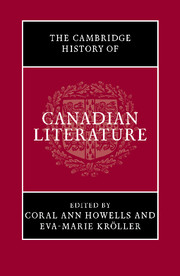Book contents
- Frontmatter
- Introduction
- PART ONE OLD AND NEW WORLD, LA NOUVELLE-FRANCE, THE CANADAS, DOMINION OF CANADA
- PART TWO THE POST-CONFEDERATION PERIOD
- PART THREE MODELS OF MODERNITY, POST-FIRST WORLD WAR
- PART FOUR AESTHETIC EXPERIMENTS, 1960 AND AFTER
- 18 Quartet: Atwood, Gallant, Munro, Shields
- 19 The short story
- 20 Canadian drama: performing communities
- 21 Poetry
- 22 Poetry, drama, and the postmodern novel
- 23 Comic art and bande dessinée: from the funnies to graphic novels
- 24 “Ghost stories”: fictions of history and myth
- 25 Indigenous writing: poetry and prose
- 26 Contemporary Aboriginal theater
- 27 Transcultural life-writing
- 28 Multiculturalism and globalization
- PART FIVE WRITING IN FRENCH
- Bibliography
- Index
- References
25 - Indigenous writing: poetry and prose
from PART FOUR - AESTHETIC EXPERIMENTS, 1960 AND AFTER
Published online by Cambridge University Press: 28 September 2010
- Frontmatter
- Introduction
- PART ONE OLD AND NEW WORLD, LA NOUVELLE-FRANCE, THE CANADAS, DOMINION OF CANADA
- PART TWO THE POST-CONFEDERATION PERIOD
- PART THREE MODELS OF MODERNITY, POST-FIRST WORLD WAR
- PART FOUR AESTHETIC EXPERIMENTS, 1960 AND AFTER
- 18 Quartet: Atwood, Gallant, Munro, Shields
- 19 The short story
- 20 Canadian drama: performing communities
- 21 Poetry
- 22 Poetry, drama, and the postmodern novel
- 23 Comic art and bande dessinée: from the funnies to graphic novels
- 24 “Ghost stories”: fictions of history and myth
- 25 Indigenous writing: poetry and prose
- 26 Contemporary Aboriginal theater
- 27 Transcultural life-writing
- 28 Multiculturalism and globalization
- PART FIVE WRITING IN FRENCH
- Bibliography
- Index
- References
Summary
Describing her first encounters with contemporary Indigenous literature in the late 1960s and early 1970s, Okanagan writer and educator Jeannette Armstrong remembers listening to Duke Redbird read his poems on CBC radio, or hunting through Indian newspapers to search out poems “scattered like gems” in their pages. To her, these works reflected “[n]ot unrequited love and romance, not longing for motherland, not taming the wilderness nor pastoral beauty … nor placing the immigrant self,” standard themes of Canadian literary criticism at the time, but rather “our own collective colonized heritage of loss, pain, anger and resistance, and of our pride and identity as Native.” Armstrong defines the early stages of a literature in Canada which is not synonymous with Canadian literature, although it has developed side by side with other contemporary Canadian writing.
In saying what Indigenous literature in the 1970s was not, she implies particular relationships to self and community, history and political power, land and story. Her comments also evoke a heady time of protest, of Black and Chicano pride imported from south of the border, and of an intense search for cultural alternatives – taken on by both Indigenous and non-Indigenous Canadians – towards a white, Anglo-Saxon, middle-class society that often saw its own assumptions as universal, or, if it acknowledged difference, as superior. Since then, Canadian literature has branched into many literatures, forms and perspectives. Contributing its own richness, Indigenous literature has also flourished, yet it remains inextricably involved with survival. It addresses Canadian readers of all backgrounds, exposing profound and subtle effects of colonialism and offering alternative points of view.
- Type
- Chapter
- Information
- The Cambridge History of Canadian Literature , pp. 499 - 517Publisher: Cambridge University PressPrint publication year: 2009



